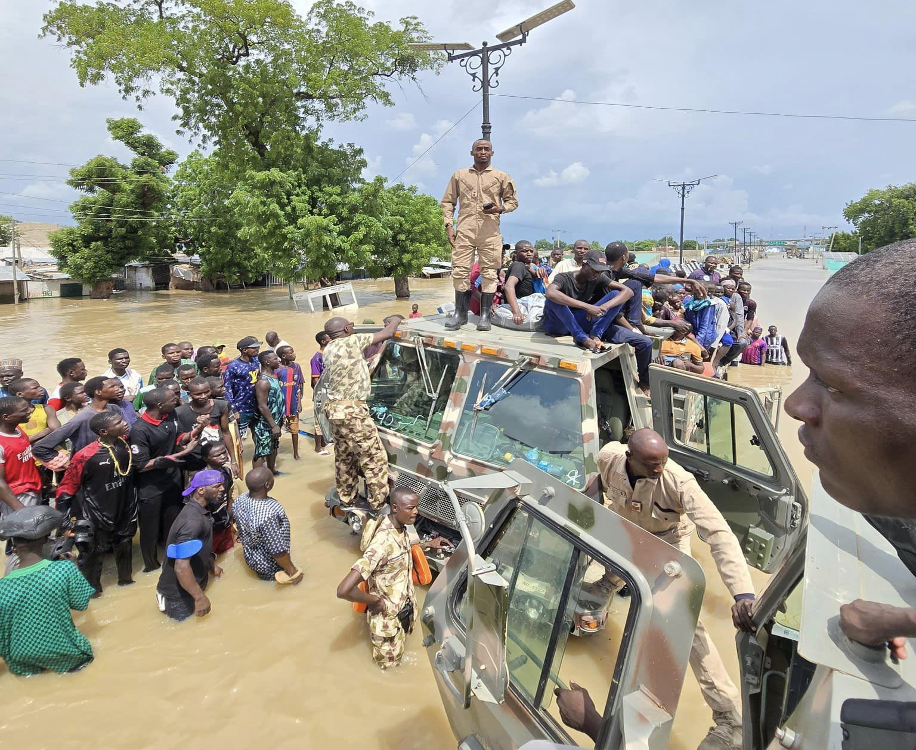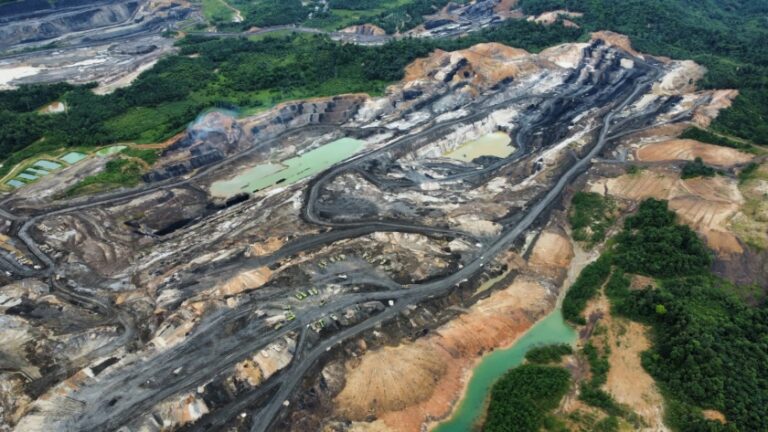In recent years, Maiduguri, the capital of Borno State, Nigeria, has experienced devastating floods that displaced thousands of residents and destroyed critical infrastructure. These events underscore the urgent need for robust disaster management systems, particularly in regions already grappling with security challenges. While the military’s primary mandate remains national defense, their capacity for rapid deployment, logistical organization, and crisis management positions them as vital players in climate disaster management. This blog explores the Nigerian military’s contributions to disaster response and early warning systems in Maiduguri, focusing on their logistical interventions, collaborative efforts with civilian agencies, and the ethical challenges that arise in such operations. By analyzing these efforts, we aim to highlight the lessons learned and propose actionable recommendations to enhance disaster preparedness and response mechanisms in Nigeria.
Military Contributions to Climate Disaster Management
The military’s involvement in climate disaster management encompasses a range of activities, from scenario planning and early warning systems to on-the-ground humanitarian assistance. The military and intelligence communities possess specialized capabilities to effectively address the rapid and complex changes resulting from climate events. Their expertise in futuring, war games, and simulations enables them to anticipate, plan for, and respond to these challenges with precision and strategic foresight. These capabilities enhance preparedness and resilience, particularly in high-risk areas.
For instance, NATO’s Euro-Atlantic Disaster Response Coordination Centre (EADRCC) exemplifies international military collaboration in disaster response. Established in the wake of devastating earthquakes in Türkiye and Greece, the EADRCC coordinates civil and military efforts to bolster resilience and facilitate disaster relief. By incorporating climate change considerations into resilience planning, NATO sets a precedent for integrating military expertise into global climate governance frameworks.
Similarly, the U.S. military’s Humanitarian Assistance and Disaster Relief (HADR) operations have demonstrated the potential for military assets to provide critical support during natural disasters. From delivering supplies to remote areas to offering medical assistance via hospital ships like the USNS Mercy and Comfort, these operations underscore the military’s capacity to address immediate humanitarian needs while fostering trust and collaboration with affected communities.
The Military’s Role in Disaster Response in Maiduguri
The Nigerian military has emerged as a crucial actor in disaster response, particularly in regions like Maiduguri, where recurring floods have compounded the challenges of an already vulnerable population. Leveraging their logistical expertise, the military has demonstrated their ability to deploy resources swiftly, provide emergency shelters, and ensure security during disaster events.
For example, during the recent floods in Maiduguri, soldiers ferried stranded residents to safety, distributed essential supplies, and coordinated with local leaders to address immediate humanitarian needs. In addition to rescue operations, the military supported the establishment of temporary camps for displaced persons. Collaborating with the State Emergency Management Agency (SEMA), military units provided transport for stranded families and medical assistance to those suffering from waterborne diseases. This multifaceted approach showcases the military’s ability to complement civilian disaster management strategies while addressing the immediate needs of affected communities.
Early Warning Systems and Preparedness
An essential aspect of climate disaster management is the development and implementation of early warning systems. The Nigerian military, in collaboration with the National Emergency Management Agency (NEMA), contributes significantly to this effort by collecting and disseminating meteorological data. These systems are critical for predicting potential disasters, enabling communities to prepare adequately.
However, gaps remain in strengthening local preparedness, particularly in flood-prone regions like Maiduguri. Military contributions to early warning systems can be enhanced through scenario planning, simulations, and the establishment of community-based alert mechanisms. Drawing lessons from international practices, such as NATO’s Euro-Atlantic Disaster Response Coordination Centre (EADRCC), the Nigerian military could organize joint training exercises with civilian agencies to improve coordination and build resilience.
For instance, NATO’s incorporation of climate change considerations into disaster response planning demonstrates the value of integrating military capabilities with broader resilience frameworks. By adopting similar strategies, the Nigerian military can bolster its role in mitigating the impacts of climate disasters and fostering sustainable development in vulnerable regions.
Case Study: The Nigerian Military’s Role in Maiduguri Flood Response
The Nigerian military’s response to the recent flood disaster in Maiduguri, Borno State, illustrates how localized military interventions can significantly mitigate the impacts of climate-induced crises. Displaced families, many of whom lost their homes and possessions, benefited from the military’s rapid deployment of personnel and resources. Key contributions included:
- Search and Rescue Operations: Soldiers ferried stranded individuals to safer locations and facilitated evacuations from high-risk areas.
- Relief Distribution: Essential supplies such as food, water, and medical aid were distributed to flood victims, alleviating immediate suffering and preventing the spread of waterborne diseases.
- Infrastructure Support: The military collaborated with local authorities and aid organizations to establish temporary camps and relocation sites for displaced residents.
These efforts were complemented by the Nigerian Air Force’s airlift missions, which transported relief materials to inaccessible areas, demonstrating the military’s adaptability and commitment to humanitarian assistance.
Challenges and Ethical Considerations
Despite their critical contributions, the military’s involvement in disaster management is not without challenges. One significant issue is the militarization of disaster response, which can lead to strained civilian-military relations. In Maiduguri, a region already affected by conflict, the presence of armed forces in humanitarian operations raises concerns about neutrality and inclusivity.
Ethical considerations also arise from the potential for unequal distribution of aid and the prioritization of security over humanitarian needs. The principle of “do no harm” must guide military-led disaster interventions to ensure that affected populations do not feel alienated or sidelined. Furthermore, clear boundaries between military and civilian roles must be maintained to avoid undermining democratic governance and social sustainability.
Another challenge is the limited resources available to the military for disaster management. While their capacity for rapid response is commendable, long-term investments in infrastructure, training, and equipment are necessary to sustain effective disaster interventions. Collaborative efforts with international partners, NGOs, and private sector actors can help address these resource constraints and promote a whole-of-society approach to disaster management.
The Importance of Civil-Military Collaboration
Effective disaster management requires a whole-of-government approach that leverages the strengths of both civilian and military actors. Civil-military cooperation is particularly vital in addressing large-scale crises that exceed the capacity of civilian agencies alone. Key strategies for fostering collaboration include:
- Integrated Planning: Joint training exercises and scenario-building workshops can enhance mutual understanding and preparedness.
- Clear Communication: Establishing protocols for information sharing and decision-making can mitigate conflicts and improve coordination.
- Capacity Building: Investing in civilian disaster management capabilities can reduce dependence on military resources, ensuring a balanced and sustainable response.
Lessons from Global and Local Responses
The experiences of NATO, the U.S. military, and the Nigerian Armed Forces provide valuable insights into the potential and pitfalls of military involvement in disaster management. These lessons include:
- Adaptability: Military forces must balance their traditional combat roles with the demands of humanitarian assistance, as demonstrated by the Nigerian military’s dual focus on counterinsurgency and disaster relief in Maiduguri.
- Resource Allocation: The strategic deployment of specialized assets, such as hospital ships and airlift missions, can enhance the efficiency and effectiveness of disaster response efforts.
- Community Engagement: Building trust with affected communities through transparent and culturally sensitive interventions is essential for long-term recovery and resilience.
Conclusion and Call to Action
The Nigerian military’s involvement in climate disaster management, as demonstrated in Maiduguri, highlights their potential to play a pivotal role in addressing the growing threat of climate-induced disasters. However, for their efforts to be truly effective, they must be integrated into broader disaster management frameworks that prioritize transparency, inclusivity, and collaboration.
Moving forward, it is essential to foster stronger partnerships between the military, civilian agencies, and local communities. Joint training exercises, investments in early warning systems, and the establishment of clear protocols for civil-military cooperation can enhance preparedness and response capabilities. By embracing a holistic approach to disaster management, Nigeria can build resilience against climate change and ensure that vulnerable populations receive the support they need in times of crisis.










+ There are no comments
Add yours